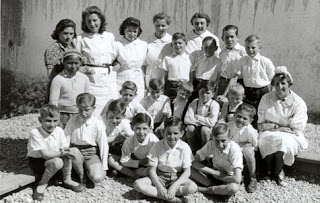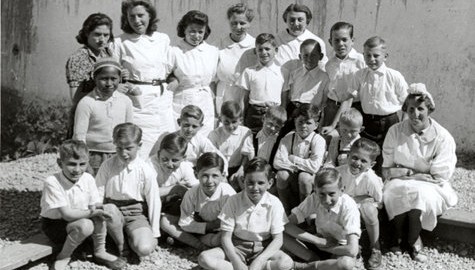Today is Yom HaShoah in Israel, Israel’s Holocaust remembrance day. Coinciding with this fact, the American Jewish Joint Distribution Committee (usually just called the JDC or the Joint) has released a new section of their website called Our Shared Legacy which contains two large databases of interest to Jewish genealogists.
 |
| Child Refugees in Bolivia helped by the JDC |
The first database is their Photo Galleries, which contains photographs from all the countries where the Joint operated when helping Jewish refugees from the Nazis to flee, and to resettle after the war. The Joint also assisted Jews to flee Eastern European countries affected by the Communist takeover in the post-war years. Countries which have photo galleries include, Australia, Austria, Belgium, Bolivia, Brazil, China, Cuba, Cyprus, Czechoslovakia, Dominican Republic, Ecuador, France, Germany, Italy, Japan, Lithuania, Morocco, Netherlands, Norway, Poland, Portugal, Spain, Sweden and Uruguay.
If you spot someone in one of the photos that you know the identity of, you can click on a link to submit their identity.
The second, and much larger, database is their Names Index. The Names Index contains 500,000 names from a series of files which document the JDC’s assistance programs worldwide. For every name in the database, they have a scanned version of the original document which you can view online in high resolution. This is truly an amazing resource.
Two of the larger card files which have been scanned and indexed on the site include what they called the Jewish Displaced Persons and Refugee Cards, 1943-1959, and the Transmigration Bureau. On site they describe these two resources as follows:
Jewish Displaced Persons and Refugee Cards, 1943-1959
After the fall of France, tens of thousands of Jewish refugees seeking to flee Nazi Europe streamed into Spain from France. JDC set up an office in Barcelona and provided support, housing and emigration assistance to these refugees. JDC also assisted refugees waiting for emigration papers and passage on transatlantic vessels. This collection contains index cards from 1943-1945 for 8220 refugees supported by JDC.
and
This is a collection of registration cards of Jewish survivors who registered with the Emigration Department of JDC in Munich and Vienna after World War II for help in emigrating to countries other than Israel. The database includes individual cards from 1945-mid 1950s for 51,554 Displaced Persons in Munich and 25,374 Displaced Persons in Vienna.
Transmigration Bureau
The Transmigration Bureau was established by JDC in New York to help refugees emigrate from Germany, Austria, Czechoslovakia, Holland, Belgium and Luxembourg, primarily to the U.S. Its primary role was to accept deposits from friends or family overseas towards the travel costs of Jews emigrating from Europe. Included are deposit cards for 37,732 individuals who emigrated from 1940-1956, with the bulk from 1940-1942.
In addition to these large card files which make up the bulk of the entries in the database, there are many smaller lists. Interestingly, in addition to viewing the single page that your database hit shows up on, they also allow you to download the entire list from which your hit came from (only for the lists, not for the large card files), even though these files can be hundreds of megabytes.
Some of the lists I’ve come across include:
- Aid to Rabbis in the Russian Empire and Palestine, 1916
- Beneficiaries of JDC’s Free Parcel Service in the Soviet Union, 1943-1945
- CARE Packages to DP (Displaced Persons) Camps I, 1946-1948
- European Jewish Refugee Arrivals from Havana to Miami, 1944-1945
- Ezras Torah Fund, 1948
- JDC Shanghai Refugee Client List, 1950
- Jewish Refugees in Italy Receiving Aid, 1946
- Polish Jewish Repatriates Following World War II, 1948
- Rabbinical Students in Shanghai II, 1947
- Refugees in Zbaszyn, Poland, 1938-1939
- Shanghai Clients Registering for Emigration to Canada, 1948
- Vilna Refugees, 1940
I haven’t seen a way to jump directly these lists, but if you search for someone and they show up on one of the lists, you will be able to view the page they show up on, or download the whole list. In some cases they also have explanatory documents connected to the lists, such as letters written at the time related to the lists. For example, in the case of the CARE package sent to DP camps after the war, they have scanned the original brochure they used to raise money to send those packages.
Another interesting thing about the lists is that some of them list relatives in the US when they were known. This is presumably to help the JDC contact the relative to work out their immigration to the US. For example, in the Refugees in Zbaszyn list, there are different sections of the list, including a section listing the addresses of US relatives which lists the following information on each refugee:
- Given Name
- Surname
- Date Born
- Town Born
- Occupation
- Last Town Lived in Germany (since these were refugees from Germany)
- Present Address in Zbaszyn (street address)
- Address of Relatives (in US)
- Degree of Relationship (i.e. cousin, sister, brother, aunt, etc.)
Obviously this is a treasure trove of information for people who find their relatives on this list, but there are some other interesting aspects to this list. For example, I’ve noticed that when listing the name of a brother as the relative in the US, the surname is not always the same. This means this list can be used to find out name changes between Europe and the US. Some quick examples include:
- Grobulska, brother’s surname is Godwin
- Fuhrman, brother’s surname is Blatter
- Loszak, brother’s surname is Wachtel
- Mazur, brother’s surname is Maltzer
- Glaser, brother’s surname is Glass
- Schueterman, brother’s surname is Brand
Some of might be predictable (somewhat) but in general the ones I’ve listed are not logical where you could easily guess such a name change.
Also, you might actually want to search this list not for the refugees but for your relatives from the US, as it can show you relatives you may not have known about in Europe (especially if you didn’t know what the surname was in Europe).
For the Zabaszyn list in particular, I should add that there are actually several lists, mostly from Zabaszyn, but there is also a list of refugees in Kolomyja (Stanislawow) from 1939. Looking at the date stamped on this list, it was created just weeks before the Nazis invaded Poland.
Overall, this is a truly amazing new resource that the JDC has provided Jewish researchers, and I hope they will continue to add to this resource over time, making the rest of their archives accessible to the public in this fashion.
